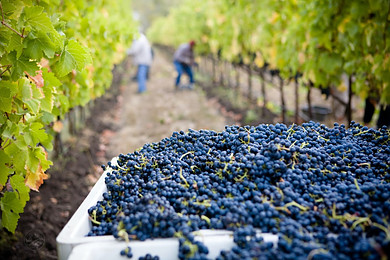During this period, many winegrowers have asked themselves whether I am ready for the grape harvest and what they still have to do to be absolutely prepared. It took a lot of time, care, and a lot of sweat to meet the expectations of every winegrower who quietly and fearfully cultivated grapes throughout the year. How much thought and effort was put in, and how much fear was endured? Constant worries about frost, disease, hail, etc., grew up with the vinedresser. So it is not strange, and it is all the more understandable that the words harvest or reaping mean something big, solemn, something that means life to many people.
However, since harvesting is a very demanding and responsible professional task in addition to all those idyllic, unique customs, we must also prepare thoroughly for it. That our year-round hard work will be done well at the end and will be crowned with the biggest prize – a remarkable drop of wine – let’s see what we have to do and what we must not forget.
A Vineyard Should Be Ready for the Grape Harvest
We place the overturned vines, fix the saplings in wire or tie them, and remove the remaining leaves and tops. In short, let’s make sure the grapes have as much sun and air as possible. We mow the grass – which will significantly benefit the grapes’ ripening – so moisture is not retained, increasing the risk of spreading rot.
The Equipment Also Should Be Ready for the Grape Harvest
When we have taken care of the best possible ripening of the grapes in the vineyard, we move with the preparations for the harvest to the press, the cellar, and the container. Let’s prepare and repair the tools we will need for the harvest. All utensils, cupboards, brents, tubs, etc., must be charged and wetted with water. Pre-clean the molds with a brush, cold water, and 2% soda, and only then wash with steam or hot water; otherwise, the steam could push the mold even deeper into the wood. The cause of various diseases and defects in wine, especially the smell of mold, is often the unclean container we use for harvesting.
If Necessary, Repair the Equipment
Carefully inspect the grape crusher destemmer and grape press machine. If necessary, repair them and wet the grape press machine in time. All iron parts of the grape crusher destemmer, grape press machine, and metal container that come into contact with the must must be polished with appropriate preservatives. All kinds of heavy metals, which the must melts, give an unpleasant taste and later cause various disturbances in the wine, and to the winegrower great, unnecessary worries.
Cleanliness Is Paramount in Wine Production
Harvesting containers should not be used during the year, for example, for sprays, distilleries, etc., because it is difficult to remove the smell or taste of these substances. The container for black grapes should not be used for white grapes, etc. We clean, usually also painting the working basement and the basement for wine as well, if necessary. It is nice to look into a wine cellar where there is order and cleanliness, as this will only benefit the wine. Prepare and clean the wine container. Painting barrel rings are very necessary and useful from time to time. Various varnishes are suitable preservatives for this work.
Don’t Forget about Wine Barrels
Inspection and preparation of wine barrels is certainly the most important and responsible work that a good master usually does. A good winegrower or cellarman does not entrust this task to anyone. The clean, pleasant smell ensured that the wine container was healthy and fine. Healthy barrels that have stood empty during the year and have been sulfured several times should be rinsed thoroughly with clean cold water, if necessary, with 2% soda and then with hot water or steam. To remove mold, the mold container should be scrubbed with a brush before rinsing with water.
Put Attention on the Ripening and Accumulation of Sugar in Grapes
In September and early October, we observe the ripening and accumulation of sugar in grapes almost every day. Let’s not be impatient and anxious. For example, if we have been waiting for 150 days since spring, then we can endure the last 10 to 15 days. The later quality of the wine depends on the correct harvest date, as only when the grapes are fully ripe are the substances in the must in the correct ratio. If the grapes are not too rotten, then we usually do not pick them. Most of the must is squeezed out at full maturity. If noble rot occurs, the harvest is postponed. In this way, we get wines of the highest values, and of course, the quantity is reduced accordingly. At full maturity, the grape berries are still green and translucent in white varieties; at noble maturity, the grape berries are yellow-brown. Grape berry skins become thinner, and grape juice is more fluid. We can “afford” such a noble or late harvest if the autumn is dry and warm. It is essential to select rotten grapes for red varieties because otherwise, you would get a wine with a taste of rot, mold, etc.
